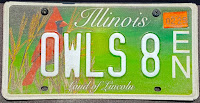The highs and lows of “owl mania”
(published 4-17-24)
In my last
column I mentioned a just-for-fun goal of seeing or hearing 25 bird species in
my yard in 2024, before the first day of spring. I came up just short, and one unexpected
miss was Great Horned Owl.
I usually
hear owls in the neighborhood regularly, during the night or just before dawn,
when retrieving our Daily Herald on the driveway. The hooting is a small
but rich aspect of suburban living.
Eastern Screech Owl by Randall Everts
Any kind of
owl encounter is special, and I lucked into a good one in February at a small
preserve in Wheaton. Until that day, I had never viewed an Eastern Screech Owl
in DuPage County or even Illinois. The species is possibly even more common
than Great Horned Owl in our region, but you’d never know it.
“Screechies”
come in two color morphs, red and gray. The bird I witnessed was a beautiful red-morph,
sunning on an open perch. I didn’t see its mate, but it probably saw me.
Screech Owls are incredibly well camouflaged, especially the gray ones.
Across the
way, in the same preserve, visitors could view a Great Horned Owl nest with
three owlets. Like the Screech Owl location, the area was marked off by yellow
caution tape to keep spectators at a respectful distance. Site managers had
stepped in to protect the birds.
People do
get excited about owls, and sometimes their enthusiasm (or thoughtlessness) gets
out of hand. A Chicago newspaper ran a front-page story in January about a pair
of Great Horned Owls in Lincoln Park being harassed by a drone. The operators expressed
no remorse. 
Protectionary measures are sometimes necessary.
Indeed, the
popularity of owls makes them vulnerable to human interference. You may
remember the “owl mania” that broke out when a family of Great Horned Owls
nested in a hollow tree in Fabyan Forest Preserve in Geneva. This went on for
several years around 2015. The charismatic birds were highly visible and
attracted crowds of onlookers. Many people were too close and too loud. Preserve
staffers and volunteers from Kane County Audubon did their best to manage the
circus.
Birdwatching
has rules we are expected to follow. The American Birding Association’s Code of
Ethics should be required reading. The gist: Be courteous, to the birds and to
your fellow birders.
Disclosing
the precise location of nesting owls is frowned upon. It goes against the code.Great Horned Owl (juvenile)
It’s not just owls. Last month the Forest Preserve District of Will County announced the presence of four active Bald Eagle nests. Wonderful news! But where? To protect the birds, the district does not disclose nest locations to the public. It’s a good policy.
Birders who
ask around can usually find what they’re after. I wouldn’t have seen the Screech
Owl in Wheaton without an assist. The birding grapevine is built upon trust.
I’m not sure
I know any birders who practice total secrecy when it comes to owl locations. Doing
so would be a little selfish in my opinion. Helping others experience special
birds can be a spark, leading those people into a lifetime of birding and
conservation. That sounds a little dreamy, I know, but it really happens.
“Owls might
be rivaled only by Bald Eagles as ornithological recruiting agents, inspiring
young and old to take an interest, to care about wildlife and to want to share
with others,” said Noah Comet in an insightful 2018 New York Times story
titled “The Delicate Politics of Chasing Owls.”
Delicate is
indeed the word. I strive to be an ethical birder while also being someone who shares
the joy and excitement of the hobby. Sometimes, I admit, it’s hard to be both. Bird
walk leaders feel this tension all the time.
The birding
police are out there, and some day they might haul me in for questioning. If
that happens, I will plead my case, for the owls and for the people. On the
scales of birdwatching justice, I’m going for balance.
Illinois owls (sidebar)
There’s no debate about the two most common owl species in northern Illinois: Eastern Screech and Great Horned. Both are nocturnal and their overall populations are declining according to the American Bird Conservancy.Great Horned is the husky-voiced “hoot owl” we often hear, especially in winter. Sometimes we see them as well, flying silently like giant moths or silhouetted on a perch. These are special moments for the observer.
Screech Owls are tiny and much less conspicuous. I’ve heard their “whinny” call a few times in the yard or close by. It’s an eerie sound you don’t forget.
Six other owl species are found regularly in Illinois, depending on the season: Barn, Barred, Long-eared, Northern Saw-whet, Short-eared, and Snowy.
Burrowing Owl, a rare visitor from the west, turned up at Montrose Point Bird Sanctuary in Chicago just last week. Watchers went bonkers.
In January 2012, three birders set off on an Owl Big Day and saw or heard all eight Illinois species, an amazing achievement. The veteran owlers—Steve Bailey, Pete Moxen and Jeff Smith—timed their quest perfectly, aided by knowing a Barn Owl location in advance and by 2012 being an “irruption” year for Snowy Owls in our region.
The United States is home to 19 own species. Worldwide there are 220. To learn more about them, I recommend a recently published book, “What an Owl Knows,” by Jennifer Ackerman.
Copyright 2024 by Jeff Reiter. All rights reserved.

